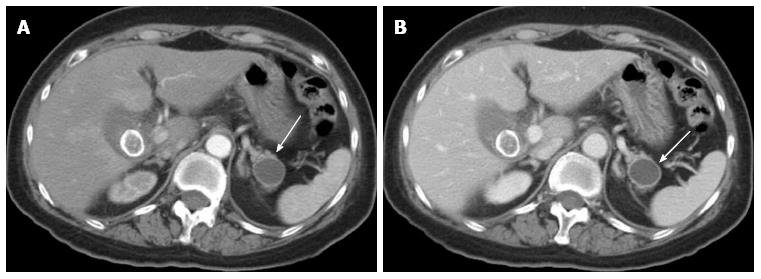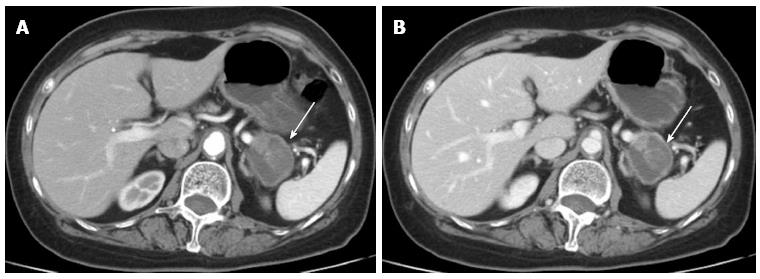Copyright
©The Author(s) 2015.
World J Gastroenterol. Jan 28, 2015; 21(4): 1357-1361
Published online Jan 28, 2015. doi: 10.3748/wjg.v21.i4.1357
Published online Jan 28, 2015. doi: 10.3748/wjg.v21.i4.1357
Figure 1 Computed tomography imaging of the abdomen the first time.
The arterial phase (A) and portal venous phase (B) revealed a 2.2 cm × 2.0 cm well-circumscribed cystic lesion that was located at the pancreatic tail with a peripheral enhancing thick cystic wall that surrounded a non-enhancing low-attenuation area consistent with cystic fluid. We diagnosed it as mucinous cystadenoma.
Figure 2 Follow-up computed tomography imaging 13 mo later.
The arterial phase (A), portal venous phase (B) and oblique sagittal contrast-enhanced computed tomography image (C) showed the lesion grew up to 2.9 cm in diameter with heterogeneous enhancement in the more thickened wall and solid component.
Figure 3 Follow-up computed tomography imaging after nearly six months.
Computed tomography (A: Arterial phase; B: Portal venous phase) showed that the original lesion in the pancreatic tail manifested as a heterogeneous complex mass that contained cystic and mixed solid areas that measured 4.0 cm in diameter. The solid components increased. The lesion showed progressive and heterogeneous enhancement.
Figure 4 Histological examination of the lesion.
A: Microscopy of the tumor indicated a predominance of dual disparate sarcomatous and carcinomatous components. Spindle-shaped tumor cells and well-differentiated adenocarcinoma cells coexisted and intermingled (HE staining, × 200); B: Cytokeratin 7 immunostaining showed strong and diffuse expression in the ductal adenocarcinoma cells (× 200); C: Sarcomatous cells were immunopositive for vimentin (× 200).
- Citation: Shi HY, Xie J, Miao F. Pancreatic carcinosarcoma: First literature report on computed tomography imaging. World J Gastroenterol 2015; 21(4): 1357-1361
- URL: https://www.wjgnet.com/1007-9327/full/v21/i4/1357.htm
- DOI: https://dx.doi.org/10.3748/wjg.v21.i4.1357
















